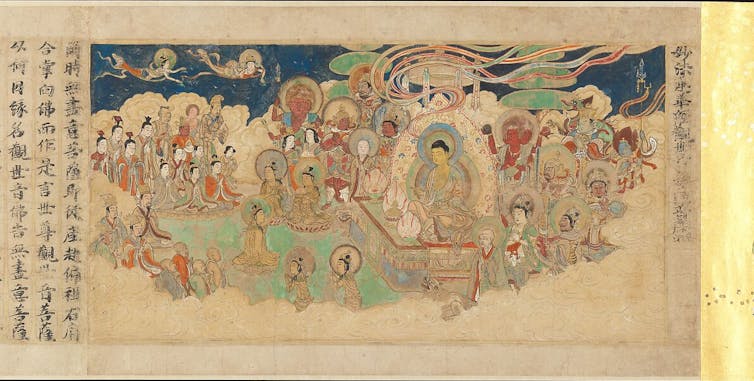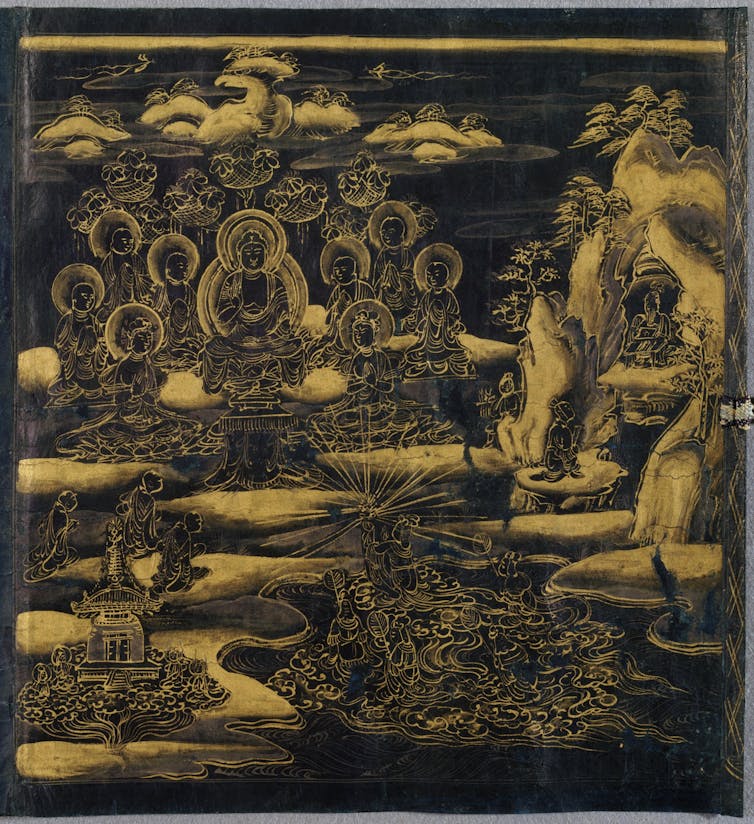The Lotus Sutra − an ancient Buddhist scripture from the 3rd century − continues to have relevance today
The Lotus Sutra − an ancient Buddhist scripture from the 3rd century − continues to have relevance today

State legislatures across the United States have introduced over 400 bills to limit transgender Americans’ rights. Many of these bills’ sponsors, such as the Christian nonprofit Alliance Defending Freedom, cite Christian values as well as the values of the other Abrahamic faiths – Judaism and Islam – to justify their anti-trans positions.
The Alliance Defending Freedom claims that Christians, Jews and Muslims view gender as binary and defined only by biology, though these religions’ diverse followers actually hold a range of views on LGBTQ+ issues. Historically, these religions were often more accepting of varied gender identities before colonialism imposed binary gender as a universal concept.
Religious values from multiple traditions have supported transgender identity. As a scholar of Buddhism and gender, I know that several Buddhist texts treat gender as fluid. One such text is the Lotus Sutra, one of the most popular Buddhist scriptures in East Asia. Its core message is that everyone, no matter their gender or status, has the potential to become a Buddha.
The Lotus Sutra conveys its message of universal Buddhahood in several stories that depict transformations between male and female bodies. For example, a dragon girl instantly transforms into the masculine body of a Buddha, proving that female bodies are not barriers to awakening.
Elsewhere, the Lotus Sutra describes how the bodhisattva Avalokiteshvara, known as Guanyin in Mandarin and Kannon in Japanese, takes on male or female forms depending on the needs of the audience.
The dragon girl’s gender transformation
To understand the story of the dragon girl, it is important to understand how Buddhas’ bodies were defined as masculine in early Buddhism. Most people are familiar with the historical figure Siddhartha Gautama as “the Buddha,” but Buddhists believe that several “Buddhas,” or enlightened teachers, have been born throughout history. All of these Buddhas are said to possess 32 marks that distinguished their bodies from regular bodies.
One of these marks was a sheathed penis, which meant that Buddha bodies were male by definition. In addition, Buddhist texts identified five roles, including Buddha, that were off-limits to women.
In the Lotus Sutra, the Buddha’s disciple, Shariputra, refers to these limitations when he rejects the idea that the dragon girl could quickly attain Buddhahood:
“You suppose that in this short time you have been able to attain the unsurpassed way. But this is difficult to believe. Why? Because the female body is soiled and defiled, not a vessel for the Law. How could you attain the unsurpassed bodhi? … Moreover, a woman is subject to the five obstacles. First, she cannot become a Brahma heavenly king. Second, she cannot become the king Shakra. Third, she cannot become a Mara demon king. Fourth, she cannot become a wheel-turning sage king. Fifth, she cannot become a Buddha. How then could your female body attain Buddhahood so quickly?”
However, the dragon girl proves Shariputra wrong by instantly attaining Buddhahood, transforming her young, female, nonhuman body into the male body of a Buddha. Women in premodern East Asia found inspiration in the dragon girl’s story because it showed that their own female bodies were not barriers to enlightenment.

The bodhisattva’s gender fluidity
Another inspiration from the Lotus Sutra can be found in the Chapter of Universal Salvation, which focuses on the bodhisattva of compassion, Avalokiteshvara. A bodhisattva is an advanced spiritual being who postpones enlightenment to help people in the world.
According to this chapter, Avalokiteshvara will adopt any form to save people. Avalokiteshvara can become a monk, nun, layman, laywoman, rich man, rich man’s wife, young boy, young girl, human or nonhuman, depending on the audience’s needs.
In China, this passage provided scriptural support for Avalokiteshvara’s perceived transformation from a male to female figure. Indian Buddhist texts described Avalokiteshvara as male, but in China people came to see Avalokiteshvara as female.
Though scholars have not found one single explanation for this transformation, the Lotus Sutra passage offers justification for Avalokiteshvara’s gender fluidity. Images of Avalokiteshvara from China, Japan and Korea can depict the bodhisattva as masculine, feminine or androgynous.
The Lotus Sutra and transgender inspiration
Due to the Lotus Sutra, Avalokiteshvara has become an inspiration and icon for transgender, gender-fluid and nonbinary people in and beyond East Asia. At Japan’s Shozenji Temple, head nun Soshuku Shibatani, who underwent gender reassignment surgery, has said, “The Kannon Bodhisattva has no gender identity,” using Avalokiteshvara’s Japanese name.
A blog post from Taiwan quotes from the Lotus Sutra in describing Avalokiteshvara as a nonbinary figure who transcends any single gender identity.
However, Avalokiteshvara’s role as a transgender icon is not universally accepted. Another Taiwanese blogger reported that a friend of theirs argued with their description of the bodhisattva as transgender. In April 2022, an Avalokiteshvara statue in The Burrell Collection in Glasgow, Scotland, labeled as a transgender icon, resulted in protests. The anti-trans group For Women Scotland argued that the label unnecessarily politicized the statue.
Despite these objections, more and more people have found inspiration in Avalokiteshvara as a transgender, nonbinary or gender-fluid figure. Just as the Lotus Sutra’s story of the dragon girl inspired Buddhist women in premodern East Asia, Avalokiteshvara’s gender fluidity offers inspiration to people today.
MJ Posani, an undergraduate student at the University of Tennessee, contributed to the research for this article.![]()
Megan Bryson, Associate Professor of Religious Studies, University of Tennessee
This article is republished from The Conversation under a Creative Commons license. Read the original article.
Không có nhận xét nào: